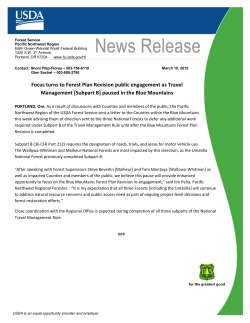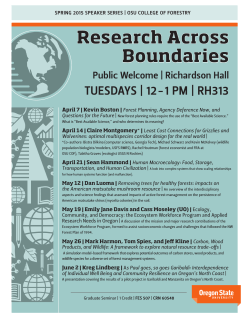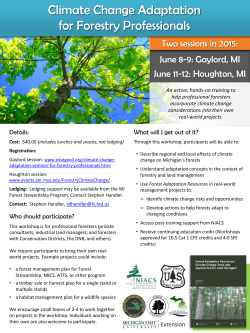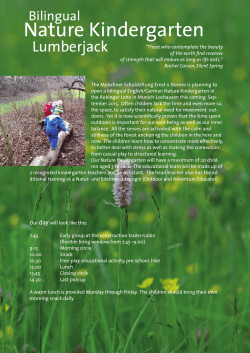
The Tasmanian RFA has been in place since 1997. It seems
The Tasmanian RFA has been in place since 1997. It seems reasonable to expect that during the intervening 18 years, more confidence could be placed on the Commonwealth's capacity to report on Montreal Process criteria and indicators. Unfortunately the State Of the Forests Report (SOFR) falls short in several areas. Criterion 1: Conservation of biological diversity According to the National Forest Policy Statement (1992), The Governments recognise the unique nature of Australia's biota and that the natural inter-relationship between native flora and fauna is essential for the health of the forest ecosystem. Accordingly, they will manage for the conservation of all species of Australia's indigenous forest fauna and flora throughout those species' ranges, and they will maintain the native forest cover where a reduction in this cover would compromise regional conservation objectives, consistent with ecologically sustainable management. However, the SOFR continues an approach that infers forests will endure outside of this naturalinter-relationship. The outcome is a perception that logged forests will regrow as before and conversely, in forests that are excluded from logging, conservation of biological diversity has been maintained and forest health will not be a concern. Regrettably this has not been the case in other RFA areas and there is no reason to think Tasmania would be any different. Criterion 2: Maintenance of productive capacity of forest ecosystems Reporting on this criteria takes a similar approach referring to the area available for timber production. While there is an assumption that eliminating native fauna will not reduce forests' productive capacity, one purpose of the RFA was to provide accurate data across tenures. However the SOFR indicates “ . . . The area of private native forest available for timber production is difficult to determine and hence no reliable data are available”. With regard to productive capacity, one aspect of the RFA has been the “Tasmanian Community Forest Agreement Intensive Forest Management Programme.” Under this programme - The Australian and Tasmanian governments will implement new initiatives to support and maintain the supply targets of a minimum 300,000 cubic metres per year of high-quality eucalypt sawlogs and veneer logs and 10,000 cubic metres per year of blackwood sawlogs to industry. Those initiatives are being implemented to offset any resource supply impacts in the medium or long term caused by changing clear-felling practices in old-growth forests or the increased reservation of old growth. Responding to an audit on this $115 million program Forestry Tasmania indicated While the proportions of plantations subject to regime change remain unclear, perhaps of greater concern are observations indicating inadequate growth may be within areas that were previous rated as 'High productivity'. Despite these limitations and concerns the SOFR suggests Ensuring the regeneration of native forest or the re-establishment of plantation is an essential requirement for sustainable long-term wood supply. Forest Practices Authority (FPA) annual assessments indicate that over the five year reporting period on average the regeneration of native forests or re-establishment to plantations has been achieved across tenures. The standards achieved on State forest were particularly good, while a detailed study of regeneration success of native forest on private land from 2002 to 2011 verified that adequate levels of reforestation are generally being achieved on private land. The SOFR also indicates While the number of wallabies or brushtail possums harvested for crop protection or recreational hunting remains relatively stable in recent years, the sale of meat or skins fluctuates widely with market demand. The harvest of deer has steadily increased over the last ten years with the number of licences sold continuing to increase. The numbers of native animals are an indication of soil fertility, yet the relationship between forests and animals is perceived as being one of conflict. Criterion 3: Maintenance of ecosystem health and vitality The SOFR indicates Some forests have suffered severe die-back, triggered by prolonged drought, and exacerbated by browsing. Affected areas include E. coccifera and E. gunnii forests on the Central Plateau, and trees and understorey species in eastern, northeastern and midlands forests. The return to wet conditions in 2010 has improved the health of vegetation in many areas, though it remains in a weakened state. Eucalyptus die-back associated with prolonged dry weather, in this case 3 months over summer, was first observed in production forests on the NSW far south coast in 1998. Another more extensive and prolonged die-back event occurred from 2002 til 2004, on this occasion extending to forests on the mid north coast of NSW. In addition, tall wet eucalyptus forests are subject to the key threatening process Bell Minor Associated Die-back, that is working with other factors to convert these forests into viney scrub or thickets. The area of public native forest which is potentially available for timber production has decreased by a further seven per cent over the last five years. Public forest area potentially available for harvesting as at June 2011 is 563 000 hectares out of total public forest area of 2 218 000 hectares. Reasons for this reduction include Forest Practices Code requirements, and assessments that some forest cannot be physically or economically harvested. Criterion 4: Conservation and maintenance of soil and water resources The objectives of the Forest Practices Code provisions in relation to soil and water are to minimise soil erosion, compaction, nutrient loss and landslides and to maintain acceptable water quality and flow. This code applies over private land, multiple-use State forest and unallocated Crown land. As previously indicated the “Tasmanian Community Forest Agreement Intensive Forest Management Programme.” relied on “A rapid field method for assessing site suitability for plantations in Tasmania’s State forest” (Laffan 2000). According to this document sites were allocated to four productivity classes based on soil and site attributes and attributed with a Mean Annual Increment. These classes are High (MAI > 20), Medium (MAI 15-20), Low (MAI 10–15) and Very low (MAI < 10). While the area of these classes incorporated into the intensive forest management program are not known, there is a concern that soil limitations are not being adequately considered. For example, Tasmanian forest soil fact sheet no.15 Mckay soil – texture-contrast soil in granodiorite, under dry forest, indicates high levels of exchangeable sodium at depth. This particular limitation has been associated with reducing water holding capacity and susceptibility to die-back associated with dry weather and drought. Criterion 5: Maintenance of forest contribution to global carbon cycles While noting the expected improved accuracy as methods of estimating forest biomass, as refinement continues. The SOFR also indicates “ . . The estimates are spatially interpolated using relationships between site productivity mapping and data on plots where there has been no known recent disturbance (Richards and Brack 2004).” Employed in the estimates are Point-based estimates of above-ground forest biomass at maturity from a collation of data (published and unpublished) by CSIRO Forestry and Forest Products (Raison et al. 2003). and Conversions to total biomass (including roots) from above-ground biomass were calculated from conversions by Snowdon et al. (2001) (NCAS Technical Report No. 18). As indicated in the latter document - The allometric relationships available do not cover representative vegetation types across the continent, under represented types include rainforests, woodlands and shrublands. There is a bias towards production forest species and small trees. Snowdon et al. (2001) The following table reproduces data from the 2002 and the 2012 SOFRs. M a j o r v e g e ta ti o n g r o u p M e a n a b o ve g ro u n d b io mAare s sa (t2 /0h0a2) (0 0 0M' he a )n a b o ve g ro u n d b io m Aa sresa (t2/ 0h 1a 0) (h a ) A c a c ia fo r e s t a n d w o o d la n d 218 3 203 14 269 A c a c ia s h r u b la n d 0 0 115 855 C a l litr is fo r e s t a n d w o o d l a n d 109 0 121 172 C a s u a r in a fo r e s t a n d w o o d l a n d 118 16 131 12 029 E u c a l yp tu s l o w o p e n fo r e s t 138 11 148 14 830 E u c a l yp tu s o p e n fo r e s t 134 1921 198 1 895 115 E u c a l yp tu s o p e n w o o d la n d 95 461 146 65 506 E u c a l yp tu s ta ll o p e n fo r e s t 177 619 206 738 158 E u c a l yp tu s w o o d la n d 115 111 196 520 402 H e a th 0 0 147 155 485 L o w c lo s e d fo r e s t a n d c lo s e d s h r u b la n d 1 6 2 217 199 242 003 O th e r fo r e s t a n d w o o d l a n d 162 36 190 34 561 O th e r s h r u b la n d s 0 0 151 59 586 R a i n fo r e s t a n d vin e th ic k e ts 187 706 204 816 624 T o t a ls 1615 4101 3382 4 569 593 While noting the 2002 SOFR was an initial effort, one of the uncertainties with the data is the lack of variation in mean above ground biomass. In essence the data does not reflect forests that contain the most biomass, suggesting instead that Eucalyptus tall open forest has similar volumes of above ground biomass per hectare as Rainforest and vine thickets or Acacia forest and woodland. More recent studies suggest significant differences between biomass volumes in rainforest and adjacent or co-occurring tall eucalyptus forest. “ . . . Sixteen paired measurement plots were selected at locations ranging from the Styx River valley to near Lake Gordon, in adjacent areas of Rainforest and mature (> 110 year old) Tall Eucalypt Forest. Measurements were collected from trees within the plots and allometric functions were used to convert these to estimates of biomass. Analyses of these data indicated that total live and dead biomass was significantly (P<0.01) lower on the Rainforest plots than eucalypt plots. On eucalypt plots, average biomass was 1170 tonnes per hectare (t/ha), equivalent to 2,145 tonnes carbon dioxide equivalent per hectare (t CO2e/ha) and on Rainforest plots average biomass was 590 t/ha (1,080 t CO2e/ha)” TASMANIAN FOREST CARBON STUDY Authored by: Barrie May, James Bulinski, Adrian Goodwin & Stuart Macleod ,CO2 Australia Limited 31 July 2012 Globally there are concerns about how forests will evolve with ongoing atmospheric change. Recent data from Amazon rainforest indicates “ . . . Rates of net increase in above-ground biomass declined by one-third during the past decade compared to the 1990s. This is a consequence of growth rate increases levelling off recently, while biomass mortality persistently increased throughout, leading to a shortening of carbon residence times. Potential drivers for the mortality increase include greater climate variability, and feedbacks of faster growth on mortality, resulting in shortened tree longevity5. The observed decline of the Amazon sink diverges markedly from the recent increase in terrestrial carbon uptake at the global scale1, 2, and is contrary to expectations based on models6.” Long-term decline of the Amazon carbon sink Nature 519, 344–348 (19 March 2015) http://www.nature.com/nature/journal/v519/n7543/full/nature14283.html#close Associated with the long term decline in forest carbon sink capacity, is the increasing abundance of vine thicket or scrub, as it is referred to in NSW. This to is a global issue with reports that some parts of the Amazon are now called 'liana forests'.(http://www.livescience.com/30300-invasive-vines-lianastropical-rainforests.html) Clearly vine thickets will not sequester the volumes of carbon that tall wet eucalyptus or rainforest have historically been capable of and it seems odd to lump them together. Similarly the defintions of forests need to be more specific, in particular, ' . . . whether mixed forests should be classified as rainforests, as communities transitional to rainforest or as a separate vegetation community.' Williams J.E. (2012). The Evolutionary Significance of Tasmania’s Rainforests and Associated Vegetation. A report to the Independent Verification Group, Tasmania, February 2012. Criterion 6: Maintenance and enhancement of long term multiple socio-economic benefits to meet the needs of societies The decline in native forest logging could be seen as an opportunity to focus on sustainability, particularly with regard to increasing biological activity in native forests. What could be learned from such an approach are more effective ways to manage the current plantation estate for long term high quality timber production. This would seem a sensible approach to supporting timber production, given second rotation plantaions are failing at an increasing rate. Criterion 7: Legal, institutional and economic framework for forest conservation and sustainable management Since the last reporting period there has been a substantial transfer of forested land from private forest companies and other small landowners/managers to various private forest reserve programs. As reported in Table 7.1.b.3 this figure is 79 400 hectares, an increase of 46 900 hectares in the past five years. Concerns about unsustainable forest activities adjacent to World Heritage areas have their counterpart with concerns about these activities adjacent to properties with conservation covenants. The termination of third party rights under the RFAs is counter productive and confirms there is little regard for those that do not have similar privileges. Conclusion While the RFA may have benefited the timber industry in the short term, this benefit has come at great cost, little has been learned, the precautionary principal has been abandoned and the uncertainties have increased. Robert Bertram 12 June 2015
© Copyright 2025









